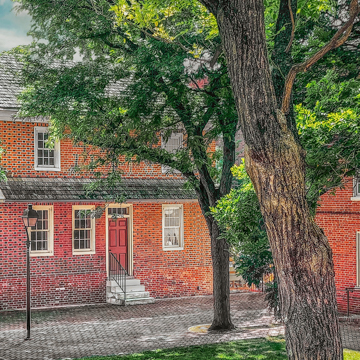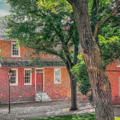Six historic brick town houses form Willingtown Square, a refuge for buildings spared the wrecking ball during the era of urban renewal. In 1964, the director of the Wilmington Housing Authority telephoned the director of the Historical Society of Delaware to alert him to the imminent destruction of dozens of houses on the East Side. The Society moved quickly to identify those especially worth saving, recognizing that “very few, if any, homes of working class peoples in urban America had been preserved” before. About this same time, the Dingee Houses were scheduled for demolition for the Government Center project—only an outcry arose from preservationists, including one who wrote the Housing Authority in 1965, “One wonders that you would have the temerity to pull down such buildings.” Working under the auspices of the Delaware Society for the Preservation of Antiquities, Albert Kruse proposed that all the preserved houses be assembled near the threatened Old Custom House (WL21) as a “village.” A later scheme (1971, George M. Whiteside) would have located them at Old Swedes Church (WL3) as the Delaware Ethnic Studies and Cultural Center. Fundraising for that location proved difficult, and, finally, the mayor of Wilmington pushed for a home adjacent to the Historical Society. They were finally moved here in 1976.
The pent-eaved Jacobs House, with 1748 in glazed bricks (formerly called the Zachariah Ferris House and dated c. 1715), from 414 W. 2nd Street, was long thought to be the oldest house in Wilmington. The Cook-Simms House (1778), originally at the northeast corner of 4th and King streets, was built by a Quaker and served as Simms Pharmacy for decades. The conjoined Obadiah and Jacob Dingee Houses (1771 and 1773, respectively), from 105–107 E. 7th Street, were built by owners who were themselves house carpenters, joiners, and cabinet makers. The double Thomas Coxe Houses (c. 1801) remained in the family of the first owner, a stone mason, until 1957. All these buildings emulate Philadelphia town houses of the day, with neat Flemish-bond brick-work (sometimes with glazed headers), projecting brick stringcourses, classical moldings under the eaves, and arched passages once leading to rear yards. As restored, they were intended to house the ethnic center, an entity that fizzled, and today are used as Society offices and storage. Like the Market Street pedestrian mall of which it formed a component, Willingtown Square represents an earnest attempt in the 1970s at addressing urban blight.












